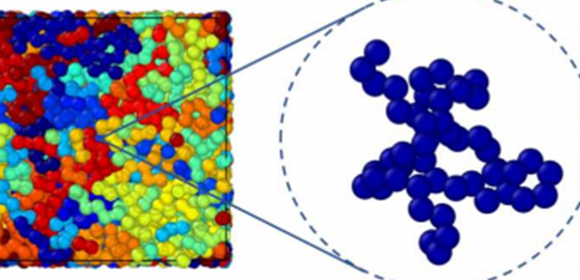
Mechanism behind the hardness of plastic clarified
A group of researchers from Osaka University, in joint research with The University of Tokyo and University of Tsukuba, has clarified the mechanisms of molecular vibration in polymer glasses such as plastic through theoretical research using computer simulations.
Plastic is a glassy state of polymers (or polymer glasses) made up of lots of units of amorphous molecules strung together in a tangled mass. However, it was unknown why such units of amorphous molecules possess such surprising strength and rigidity.
In many plastics, during a glass transition from the liquid state to the glass state, polymer chains cannot form orderly lattices because of the free, random motion of polymer chains, maintaining a random molecular arrangement like silica glass used for windows.
Glass transition temperature, a temperature at which the polymer experiences the transition from a glassy state to a rubbery state, is an important factor for optimum injection molding of plastic.
This group clarified the glass transition of polymeric systems using coarse-grained molecular dynamics simulations, with particular attention to the effects of the bending rigidity of polymer chains on properties of a polymeric system by systematically changing the bending stiffness of polymer chains.
First, they measured the elastic moduli by applying an external strain to a polymeric system. The rigidity of a polymer chain increases the overall stiffness of the polymeric system. However, as the conformation of the polymer chain has progressively changed after the deformation, the rigidity of the overall system decreased due to the influence of non-affine deformation, a geometric transformation that does not preserves lines and parallelism.
Next, they calculated the vibrational density of states (vDOS), which features the molecular vibration state in polymeric glasses, and theoretically clarified that the excess vibrational modes at low frequencies, called boson peak (BP), was also present in polymer glasses.
Since the BP frequency varied depending on the rigidity of polymer chains, the bending rigidity’s dependence of the BP frequency was found to be described by the shear modulus alone.
Clarifying properties of polymers by glass transition helps in understanding the reason why plastics harden when they get cold and in elucidating the phenomenon of glass transition in which glass materials harden in a disorganized structure when cooled.
This group clarified that the BP frequency of polymeric glasses is determined by rigidity of the polymer system. This suggests that glass transition has universal features, facilitating approaches to the theoretical development of the phenomenon.
Since the BP is observed in terahertz (THz), it is possible to evaluate plastic’s mechanical properties using THz waves in a non-destructive and non-contact manner. This will also broaden the availability of THz waves as inspection and sensing methods and provide a theoretical basis for research on it.

Figure 1

Figure 2
The article, "Boson peak, elasticity, and glass transition temperature in polymer glasses: Effects of the rigidity of chain bending," was published in Scientific Reports at DOI: https://doi.org/10.1038/s41598-019-55564-2 .
Related Links

